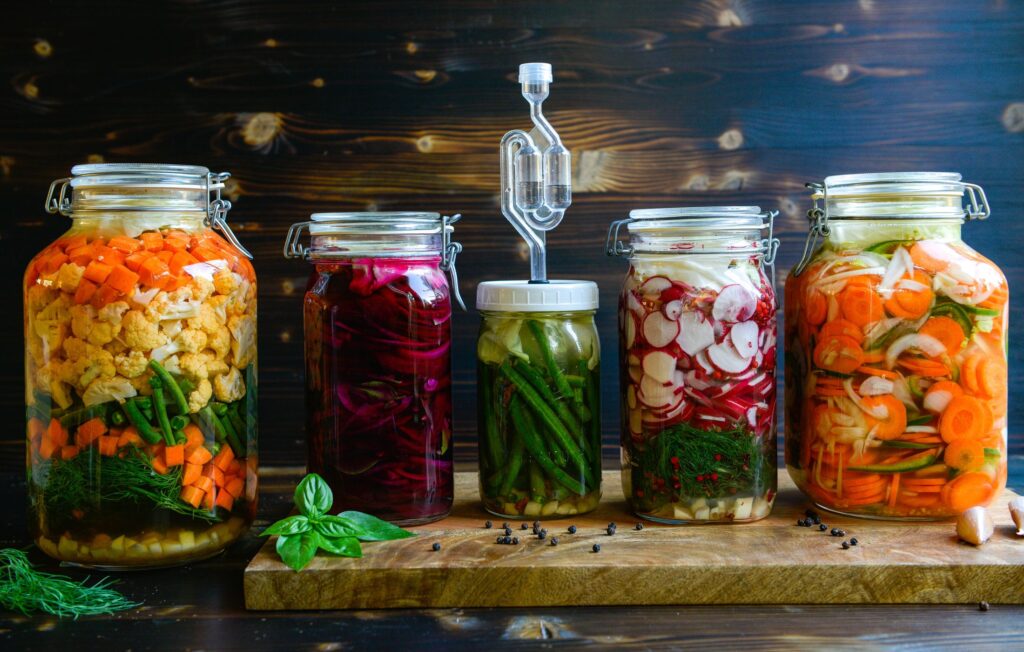Introduction
Fermented foods have taken the spotlight in health and wellness for their ability to improve digestion, strengthen immunity, and enhance overall well-being. Packed with probiotics and beneficial bacteria, fermented foods can transform your gut health while tantalizing your taste buds. In this article, we’ll explore what fermented foods are, their health benefits, popular types, and tips for incorporating them into your diet.
Table of Contents
What Are Fermented Foods?
Fermented foods are created through the process of lacto-fermentation, where natural bacteria feed on sugar and starch, producing lactic acid. This process not only preserves the food but also enriches it with beneficial enzymes, vitamins, and probiotics.
Examples of fermented foods include:
- Yogurt
- Sauerkraut
- Kimchi
- Kefir
- Kombucha
- Miso
- Tempeh
The Health Benefits of Fermented Foods
- Improved Digestion
Fermented foods contain probiotics that help restore the natural balance of gut bacteria, reducing bloating, constipation, and other digestive issues. - Boosted Immunity
A healthy gut is the cornerstone of a strong immune system. Probiotics from fermented foods enhance your body’s natural defenses, helping you fight infections more effectively. - Enhanced Nutrient Absorption
The fermentation process breaks down nutrients, making them easier for your body to absorb. For instance, sauerkraut is rich in vitamin C and beneficial enzymes. - Potential Mental Health Benefits
Emerging studies link gut health to mental well-being. Consuming fermented foods may reduce anxiety and depression by fostering a healthier gut-brain connection.
Popular Types of Fermented Foods
1. Kimchi
A staple in Korean cuisine, kimchi is made from fermented vegetables like napa cabbage and radishes, seasoned with chili, garlic, and ginger. It’s an excellent source of fiber and probiotics.
2. Kombucha
This tangy, fizzy drink is made from fermented tea and a SCOBY (symbiotic culture of bacteria and yeast). Kombucha is known for its detoxifying properties.
3. Miso
A Japanese seasoning paste made from fermented soybeans, miso is used in soups, marinades, and dressings. It’s a great source of protein and minerals.
4. Yogurt
One of the most accessible fermented foods, yogurt is rich in calcium, protein, and probiotics. Opt for unsweetened, natural yogurt for maximum benefits.
How to Add Fermented Foods to Your Diet
- Start Small: Begin with small servings to allow your gut to adjust to the increased probiotics.
- Combine with Meals: Add kimchi or sauerkraut as a side dish or topping for your main meals.
- Experiment: Try incorporating miso paste in soups or marinades and enjoy kombucha as a refreshing beverage.
- Choose Quality Products: Opt for unpasteurized and natural products, as pasteurization can kill beneficial bacteria.
DIY Fermented Foods at Home
Want to save money and enjoy fresh fermented foods? Start with easy recipes like homemade yogurt or sauerkraut. Here’s a simple recipe for sauerkraut:
Ingredients:
- 1 medium cabbage (shredded)
- 1 tablespoon sea salt
Instructions:
- Massage salt into shredded cabbage until it releases liquid.
- Pack it tightly into a jar, ensuring it’s submerged in its juices.
- Cover loosely and let it ferment at room temperature for 1-2 weeks.
Conclusion
Fermented foods are more than just a health trend; they are a time-tested way to boost gut health, enhance immunity, and improve overall well-being. By incorporating these probiotic-rich foods into your diet, you can enjoy both delicious flavors and powerful health benefits.
Start small, experiment with different varieties, and let fermented foods become your gut’s best friend!

